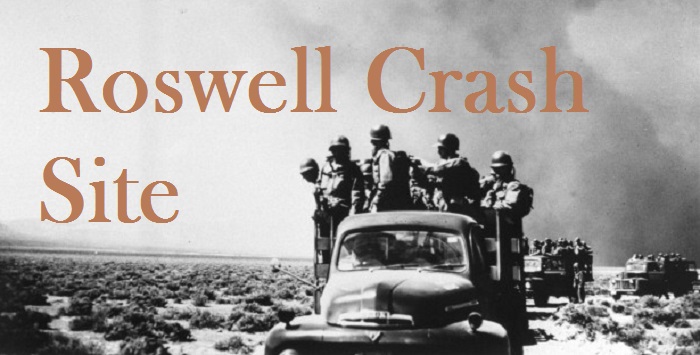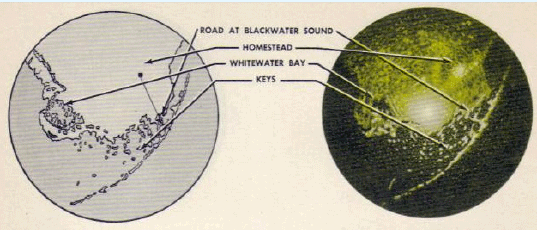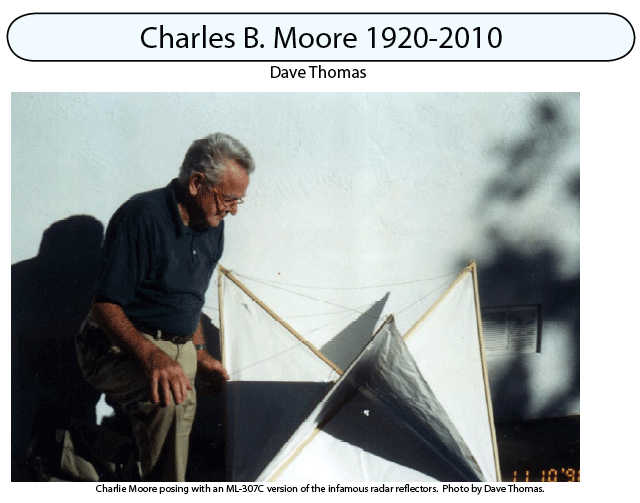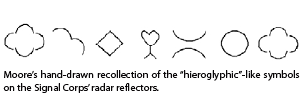.

The Roswell Corner
JARS: Just another Roswell “story”.
Mr. Bragalia continues to present us JARS for consumption on the UFO Iconclasts blog. In his latest, we are presented
the stories told by the widow of General Harry Cordes, Rogene Cordes. As always, we are fed the usual rumors and claims about an alien spaceship crash as if they are facts.
Some of her stories appear to be inaccurate.
She claims her husband was a radar operator at RAAF but that was not the case. He is listed as a radar observer on B-29’s, which means he probably operated
the B-29’s radar, which is different
than operating an air search radar. The B-29 radar is basically used to identify
a specific ground target from the air. It can also be used for navigation and gathering intelligence by identifying various ground based objects. However,
it is not designed for air search. The image below is taken from the on-line version of the “Radar observer’s Bombardment
Information File” showing the basic capabilities of the radar. We also know that there appears to be no operational air search radar at Roswell in July 1947 based on documentation produced by Robert Todd some time ago. Therefore, one has to consider that any references to radar tracking of a UFO crash as being highly suspect and it certainly was not done using the radar on a B-29.
.

The one item I found amusing in her revelations was that the entire supply of ice in Roswell was scooped up by the RAAF in July 1947. Nothing appeared in the papers and it seems unlikely that this would happen in mid-July without some serious complaints by the community.
The lack of any mention that there was a shortage of ice in town by the local media indicates that this story
should be seriously questioned. Of course, one has to wonder why would RAAF bother grabbing all the ice when they probably had these kinds of resources
on the base? Like so many of the JARS that have surfaced over the years, it is hard to accept certain parts of these stories as accurate or factual.
The Battelle-Titanium story: Case closed?
Billy Cox reports that he has received the infamous Battelle first progress report on Titanium alloys. If you recall, Tony Bragalia stated this was the study of the Roswell metal. When I saw the second progress report, it was my opinion that the “missing first progress report” was just the first sixty pages that were missing
in the second progress report (and covered the previous time period). Cox did not provide a copy of the document but did state it was 59 pages in length and simply covered previous work on Titanium alloys. It sounds like those missing 60 pages I mentioned back in SUNlite 1-3. Of course, there was no mention of studying any Roswellian metal. Was that a surprise? Can we finally
put this to bed or are we going to get more allegations and innuendo about how Battelle was feeding the Navy labs information to produce Nitinol?
Quelle: SUNlite 2/2010
.
The Roswell Corner
.
More of “a whole lot of nuthin”
Recently, an anonymous source sent me a copy of the first progress report associated with the research regarding
Titanium Alloys by the Battelle institute in 1948. However, the report later appeared on the DTIC web site for everyone to view. As I stated last issue, it is no big deal but feel free to read it for yourself. Mr. Bragalia, in another “challenge” e-mail told me that I did not have a clue and that the first report was more revealing than the second. I am not sure what he was reading but I don’t see it. The last time I discussed the progress report (SUNlite 1-3), I pointed out that Mr. Bragalia’s claims appeared to be highly exaggerated. My opinion of this did not change with the release of the first progress report.
Billy Cox states there is a feeble connection to a Mr. John Burlin (J.B.) Johnson, who happened to be the chief of the metallurgy group at Wright-Patterson. The cover letter for the report states that Johnson requested certain alloy studies made previously under a different contract be included in this report. As a result they carried forward information from the previous contract and included it. Johnson , who would be receiving copies of the report, seems to have wanted the information included because it was pertinent. These progress reports were eventually assembled together as a complete work. This is why the second progress
report started on page 61. It appears that Johnson’s intention was for them to include the previous studies in the first progress report so that the background upon which these studies were being made was included. This is not that big a deal but in “Roswell land”, things are never that simple.
In “Roswell land’s” highly complex world of government subterfuge and conspiracy, Johnson is now the linchpin associated
with Roswell. Johnson is subtly prompting these scientists to include these studies to replicate the miracle metal even though there is no hint of Roswell or any exotic metal properties (including Nitinol) in any of these reports. Roswellian logic wins out over the more simple explanation.
Bragalia has since informed me that he has linked just about every person involved
with studying Titanium at the time as being “obsessed” with UFOs. The implications of this “obsession” are that all of them knew something about Roswell
and that made them enthusiastic about studying the subject. However, I think the use of the word “obsessed” is an exaggeration. For instance, Bragalia’s
claim that Dr. Linus Pauling was “obsessed” with UFOs was shown to be without merit when I contacted Dr. Robert Paradowski. He personally knew Pauling
and was one of Bragalia’s “sources” . Dr. Paradowski stated that Pauling DID NOT have an immense library of UFO books (as claimed by Bragalia) and had only a passing interest in the subject. Like all of Bragalia’s links to Roswell it takes real imagination to create them. Mr. Bragalia seems to have plenty of that to go around.
In my opinion, suggesting these scientists and engineers were involved in some massive cover-up is not giving them the credit they deserve for all their own personal achievements. Suggesting they received “help”, in the form of some alien metal that nobody has ever seen since 1947, diminishes their accomplishments.
Stating they really did not discover these things by using rumor, innuendo, and wild stories is the same as stating their work was fraudulent. 100 Proof Roswell
Bragalia also suggests that the exposure to the Roswell UFO crash was so disturbing that it caused various people to become alcoholics. One statistic he does not mention stands out in my mind. According to statistics, there are 14 million Americans that suffer from alcohol related illnesses. Considering that there are over 300 million Americans, this means roughly 4% of the population has this problem. If we take a sample of all the Roswell witnesses and contacts that supposedly occurred (numbering in the hundreds if you listen to Bragalia et.al.), it seems likely, you would find about a dozen or so with some record of abusing alcohol.
Bragalia’s evidence (some of it based on simple rumor) is a mere five witnesses ,4who supposedly had some form of Alcohol abuse in relation to Roswell. This is well within the statistical norm for abuse. We don’t even have proof that Dr. Center (see SUNlite 1-3) or Lt. Gov. Montoya (see Pflock - Roswell: Inconvenient facts and the will to believe) were even involved with Roswell. This really cuts the list down to three people, who were known to be in the area in July 1947. If people were really affected as he claims, there would have been dozens of alcoholics and psychological breakdowns. Instead, it seems as if most people were unaffected.
In my opinion, taking advantage of people’s personal addictions/problems to publish a highly suspect story is really not good journalistic practice. Of course, this is “Roswell land”, where those willing to believe will accept and applaud this kind of garbage. For the more critical readers, it is tabloid style research meant to “shock” readers and gain notoriety.
Obersturmführer Easley?
One of the cornerstones of the Roswell legend is that base personnel and military police supposedly imprisoned people, threatened civilians with bodily harm, and damaged civilian property. If we are to believe these things actually happened, we have to consider why these men acted this way. They just did not decide
to do so on their own. They had to have had orders. Many crashed UFO proponents point to Edwin Easley as being in charge of security associated with the crashed spaceship so he would be the person giving such orders. This makes him guilty of any crimes that these men committed. Even if Easley was ordered to tell these soldiers to conduct themselves in this fashion, he would still be responsible.
If they conducted themselves this way on their own, it would be Easley’s responsibility to report it and punish those involved. There is no record of such punishments and there are no records of any orders given to Easley to allow the men to act like a bunch of jackbooted thugs. This leaves us with two possibilities.
The first is the stories of threats and damaged property are highly exaggerated
OR Edwin Easley is responsible for the despicable actions of his men. I think the first possibility is most likely. Why do proponents paint a scenario that makes Easley the bad guy but then portray him as a saint? You can’t have it both ways.
Quelle: SUNlite 3/2010
.

Professor Charles B. Moore, who played a key role in the genesis of what is known as the “Roswell Incident,” died on March 2nd in Socorro, New Mexico. Moore was a professor emeritus of physicsat New Mexico Tech, where I studied under him in the 1970s.
The “Roswell Incident” was merely a footnote in Moore’s very busy life. Moore was well known in the field of atmospheric physics, and received the very impressive Otto C. Winzen Lifetime Achievement Award of the American Institute of Aeronautics and Astronautics. The American Geophysical Union gave Moore a fellowship,
and he also received the Lifetime Achievement Award of the Atmospheric Electricity Community. Moore’s exploits included traveling in a balloon to the edge of space - 80,000 feet up – where he photographed the planet Venus without atmospheric interference for the first time. (This occurred well before modern space travel.)
As chairman of NM Tech’s Langmuir Laboratory for Atmospheric Research (located in the Magdalena mountains), Moore led world-class research on lightning
and cloud formation for years. He was a champion of blunt lightning rods; while Benjamin Franklin’s invention of lightning rods was a great achievement, Franklin’s insistence that sharp tips make for better rods (supposedly because it allows streamers to “discharge” high potentials)
has unfortunately persisted to this day. Moore evaluated many rods in a multi-year experiment at Langmuir Lab. In eight years, 12 blunt rods (one-half to one inch diameter) were struck, but no Franklin sharp rods and no early streamer devices were ever hit by lightning. Professor
Moore also provided key support for retaining lightning rod standards at the U.S. National Fire Protection Association,
where they had come under fire by promoters of pseudoscientific schemes such as “early streamer emission” methods.
Moore also worked for years with Dr. Bernard Vonnegut, the brilliant scientist who discovered that silver iodide could be used for cloud seeding. (This inspired Vonnegut’s brother, novelist Kurt Vonnegut, to write “Cat’s Cradle,” about a hypothetical and dangerous form of water called “Ice 9.” ) As one of his physics students, I was imCharles
pressed by Moore’s fairness, humility, willingness to share credit for scientific accomplishments with his juniors, and his all-around no-nonsense attitudes. After one particularly grueling electromagnetics class, I told Professor Moore that I’d found a mistake in his analysis of a lightning measurement gadget, due to neglecting the real product of two imaginary terms in the derivation. Moore politely suggested I take another look at it, but after examining it further himself, he realized I was right. Later that day, Moore came up to tell me about his find in one of the physics labs, where I was “reconditioning” (e.g. removing mouse droppings from) department oscilloscopes. He promptly took me off that task, and started me on working some tricky elliptic integrals he was using for a model of lightning bolts. Moore had no patience for sloppy work or laziness, however – on one occasion, he handed out graded papers to the entire E&M class, gingerly tendering each paper to its owner as if it was tainted.
During World War II, Moore worked with Athelstan Spilhaus, Sr., who was one of the instructors at the Army Air Corps meteorological training school,. Charlie served behind enemy lines in the China-Burma-India theater. When the war ended, he finished his undergraduate degree at Georgia Tech. He was then recruited by Spilhaus, and became a graduate student at New York University. There, he became a key member of the “Constant Altitude Balloon Project,” which had the unclassified purpose of finding out how to keep large gas balloons at the same altitude (no easy task, as when the sun sets, the air inside the balloon contracts, making them plummet). This project had a classified connection, however – its real purpose was to help deploy Project Mogul, a top-secret mission with the goal of detecting Soviet nuclear tests via measuring

rumbles from the detonations. The idea for the program traces back to the 1883 explosion of volcano Krakatoa, which was so loud that it could be heard in many cities around the globe. Analysis of those rumbles indicated that the sound waves from the volcanic eruption had been carried around the world in a natural sound-conducting layer of atmosphere between the troposphere and the stratosphere.
.

The first tests of balloon deployments, in New Jersey, failed spectacularly, so the whole group relocated to Alamogordo in the summer of 1947. The NYU group’s first launch, on June 4, 1947, was lost somewhere around Arabela, N.M. Balloon “Chase crews” in those days didn’t use jaunty pickup trucks, but instead flew B-17s that followed the balloon trains, listening for data. The complex, 600-foot-long assemblage of Flight No. 4 included two dozen balloons, three radar reflectors, some parachutes and black boxes. The reflectors were shaped like jacks – eight-sided structures made of balsa wood and tough, shiny, metallic-coated paper. A toy company in Manhattan made them on the side, and the company chose a curiously decorated tape to reinforce the reflectors. Moore launched dozens of these targets, and marveled time and again at the unknown purpose of the strange hieroglyphic-like markings on the reflectors. Ten days after the June 4 launch, rancher Mac Brazel came across a field strewn with remnants of balloons and bits of metallic foil -- almost certainly the remains of NYU Flight No. 4. Ten days after that, on June 24, pilot Kenneth Arnold reported a sighting of strange flying objects that “skipped like saucers.”
That event plunged the nation into a brief but intense “flying disk” craze, with frantic new reports of sightings of the “disks” coming every day. There was even a total of $3,000 offered for the recovery of a real disk. It was in this atmosphere, after the Fourth of July weekend of 1947, that rancher Brazel decided to take some of that strange material to the sheriff, who took it to Major Marcel at the Roswell Army Air Field (RAAF). But, Marcel’s expertise was primarily in making assessments of bomb damage from aerial photographs.
He had never seen a radar reflector;
the only time one like it had ever been used previously in New Mexico was to measure winds aloft before the first atomic blast at Trinity Site in 1945.
The unusual flexible metal paper, and especially the strange hieroglyphic-like symbols, probably combined with the national “Flying Disk” frenzy to convince Marcel that this was, indeed, a real “flying disk.” And so it was announced by the Roswell Army Air Force Intelligence Office (Marcel’s group), in a press release on July 8, 1947. When General Roger Ramey heard of this turn of events, he called for the materials and Marcel to be flown out to Fort Worth that very afternoon.
This was done, and Ramey called down his weather officer to look at the debris. This man, Irving Newton, was excited to see a real “flying disk” for himself. That is, until he walked in to the room to see what he promptly told Ramey was simply a radar target and some old weather balloons. The general held a press conference
shortly afterward, and Roswell’s 15 minutes of fame were over. At least, they were over for three decades.
In the late 1970s, the Roswell legend re-emerged from obscurity to become the best-accepted UFO case of them all. Marcel was interviewed, and declared that the materials were “not of this Earth.” Stories of government harassment and strange materials began to surface, and the legend grew. Ten years after that, after Marcel and Brazel
had died, the stories began to include the mention of alien bodies and autopsies and such.
The ‘90s became the Decade of Roswell, and the incident retains UFOdom’s “best case” mantle, although interest and attendance
has declined in recent years (see my article “Roswell Update: Fading Star?” in the Skeptical Inquirer Volume 33.1, January / February 2009).
Project Mogul was never very successful in its primary goal, and other methods were eventually adopted to track Soviet nuclear activity. The Air Force didn’t even put Mogul flights together with tales of the Roswell Incident. That connection was first realized by UFO researcher Robert Todd, and was independently discovered by Placitas writer Karl Pflock. Todd contacted Charles Moore, who told the Air Force about it, and subsequent research clinched the connection.
For decades, Moore and coworkers had thought the Roswell flap of 1947 was probably due to one of their polyethylene balloon launches in July of that year. It wasn’t until reviewing witness descriptions of the actual debris that Moore realized the “Incident” was instead one of the huge and awkward neoprene balloon trains launched in June of 1947.
Moore described his experiences to the local skeptics’ group New Mexicans for Science and Reason in 1995, and this became the genesis for my Skeptical Inquirer article “The Roswell Incident and Project Mogul” (Volume 19.4, July / August 1995, online at http://www.csicop.org/si/show/roswell_incident_and_project_mogul). Moore published another account of incident in the book UFO Crash at Roswell: The Genesis of a Modern Myth, co-authored by Benson Saler, Charles A. Ziegler, and Charles B. Moore (Washington, D.C.: Smithsonian Institution
Press, 1997). Included in this book was an analysis of weather conditions around Roswell in early June of 1947, and Moore’s conclusion that, once their balloon
train had become lost near Arabela, it most likely descended to the Foster Ranch itself, right where rancher Brazel found the remains weeks later.
While these calculations have been harshly criticized by David Rudiak, a discussion I had just a few years ago with Professor Moore, before his health had declined too much, bears directly on this criticism. And what Moore said was simply this: the publishers of the Saler/ Ziegler/Moore book mangled the table of values explaining the MOGUL trajectory calculations, and mashed together alternating rows into single, garbled rows of data. This explains much of the confusion
which Rudiak has so unfairly blamed on intentional malfeasance on Moore’s part.
In the end, Moore’s connection to the Roswell Incident were just a minor footnote in the busy life of an accomplished atmospheric physicist, space explorer, and teacher. While MOGUL and other activities led him away from getting a doctoral degree, Moore was awarded a well-deserved honorary Ph.D. degree in Physics from New Mexico Tech in 2003. He will be missed.
Editor note: Dave included an image from Dennis Balthasar’s web site showing the deck of cards he made for “debunkers” of the Roswell story. According to David, this is the Dennis Balthaser school of UFOlogical Rhetoric: “If you can’t Lick ‘Em, Demonize ‘Em” . I was disappointed that Balthasar only gave Professor Moore the nine of diamonds.
He should have been the “ace of spades”.
Quelle: SUNlite 3/2010
5217 Views
